There are 23 types of salamanders in Indiana and in total there are around 41 amphibians in the state. The wet woodlands near lakes, ponds, and streams are common areas salamanders live, but they also inhabit urban areas. Salamanders showcase a variety of colors and markings. Their size, habitat, and times of activity are also some of the differences between them. This article will cover the 23 salamanders endemic to Indiana, and the interesting things to know about them.
Salamanders are a sign of a healthy environment, as many of them rely on clean, and well-oxygenated water to live in. Their size also makes them keystone animals. Salamanders feed on a variety of small invertebrates and are used as food by things like frogs, snakes, and small mammals. Let’s take a look at the salamanders in Indiana, which are just a few found in the United States.
Table of Contents
Salamanders in Indiana
1. Eastern Hellbender
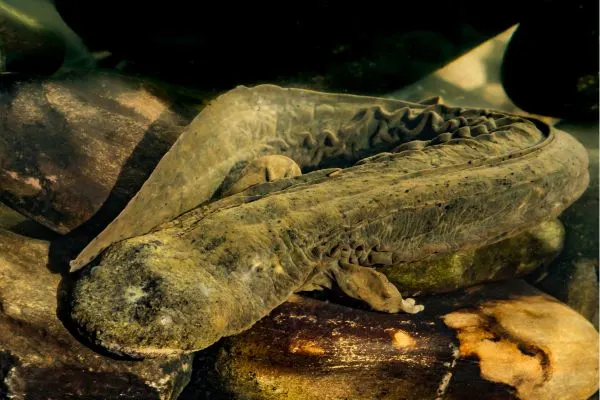
- Experience Level: Advanced
- Family: Cryptobranchidae
- Scientific Name: Cryptobranchus alleganiensis
- Other Names: n/a
- Adult Size: 13 to 24 inches (33 to 61 cm)
- Lifespan: 30 years
- Average Price Range: n/a
Hellbenders are native to the Appalachian region of North America and are found in southeast Indiana. Clean, and rocky flowing rivers are the habitats they live in. They are classified as an endangered species in Indiana, and their aquatic lifestyle makes them very susceptible to pollution. Their entire lives are spent in the water and require specific habitats to survive in.
Hellbenders are the largest salamanders in Indiana, and the largest of them have been able to grow up to 29 inches. Most are smaller, and have broad heads, with a paddle tail to help them swim. Gray, olive, or sometimes black are the colors this salamander appears in. They have a mottled pattern of spots on their back, and upper sides.
The breeding seasons for the hellbender start in August, or September. While not sexually dimorphic, males in this season get a bulging cloaca. Hellbenders mate by performing external fertilization.
Males create a brood site, where females lay between 150 to 200 eggs. A male can have up to 2,000 eggs in their nest, and fertilize them. It takes around 45 to 80 days for eggs to hatch.
Small fish, crayfish, and other amphibians are what the hellbender eats. They are opportunistic feeders, eating whatever is in abundance. Habitat destruction is the biggest threat to the hellbender. Clean, fast-moving streams are where they prefer to live. They are typically nocturnal and hide under rocks when or other debris underwater.
2. Mudpuppy
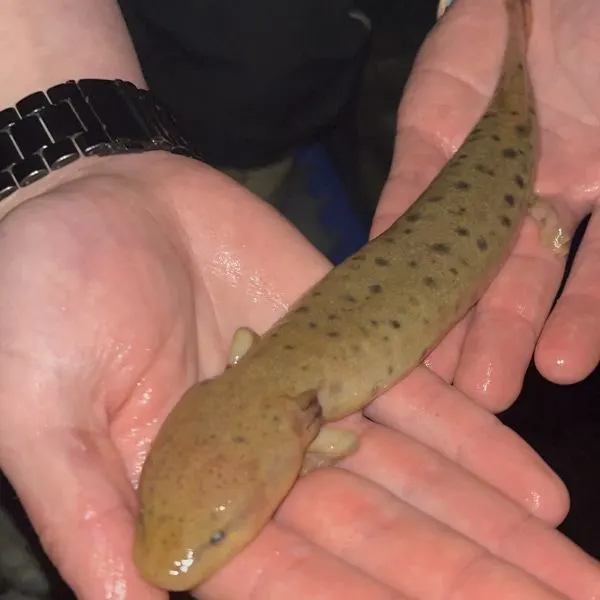
- Experience Level: Intermediate
- Family: Proteidae
- Scientific Name: Necturus maculosus
- Other Names: Waterdogs
- Adult Size: 8 to 19 inches (20.3 to 48.2 cm)
- Lifespan: 15 to 30 years
- Average Price Range: $10 to $20
The common mudpuppy is one of many salamanders that live in Indiana and is found throughout the state. Mudpuppies live in large rivers, lakes, and other similar freshwater sources. Mudpuppies are entirely aquatic and do not leave the water like other salamanders. This species is primarily found at the bottom of waters and is active year-round.
The fall is when courtship and mating for the mudpuppy occurs, sometimes happening in the winter. Males find females under rocks and deposit their sperm plug into the substrate for females to find, and use to fertilize their eggs. Around 18 to 180 eggs are laid in a nest, and take 1 to 2 months to hatch.
Mudpuppies have red gills that stick out of their neck and get larger in water with less oxygen. They have flat bodies, and short legs which are used to traverse the bottom of lakes, and rivers. Their tail is paddle-shaped, and covering their body are spots and a mottled pattern. Mudpuppies have gray to rusty brown coloring.
In Indiana, mudpuppies are classified as a species of Special Concern since they are very susceptible to population decline, pollution, and habitat destruction. Mudpuppies feed on insects, aquatic invertebrates, and whatever they can find. Water snakes, birds, turtles, and mammals are what preys on the mudpuppy in the wild.
3. Blue Spotted Salamander
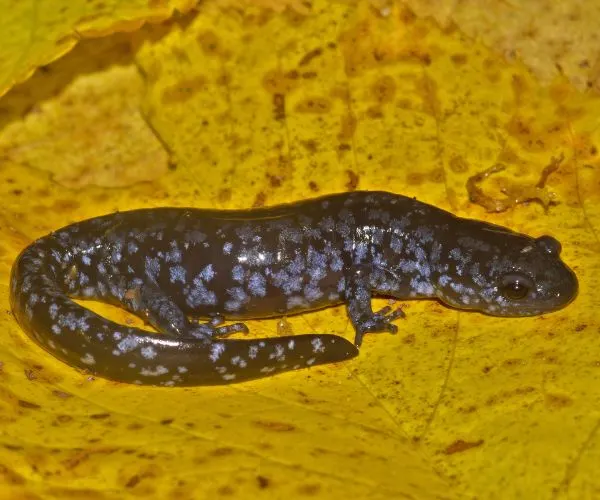
- Experience Level: Intermediate
- Family: Ambystomatidae
- Scientific Name: Ambystoma laterale
- Other Names: n/a
- Adult Size: 3 to 5 inches (7.62 to 12.7 cm)
- Lifespan: n/a
- Average Price Range: $25
The northern region of Indiana is where blue-spotted salamanders may be found, and their range covers the northeastern states of the US. Swamps, marshes, and temporary fools are where blue-spotted salamanders are found. Spring is when this species is active most, and they are nocturnal. When not active they hide under rocks, logs, and other similar debris.
The spring is also the mating season for the blue-spotted salamander. Eggs of the blue-spotted salamander are laid on the edge of woodlands, near ponds, or water ditches. Blue-spotted salamanders may lay up to 500 eggs, which take around a month to hatch. It takes around 2 years for their hatchlings to reach full maturity.
The skin of the blue-spotted salamander is dark blue, or black. They are covered in blue, or white flecks on their body, and sides. The splotches on larvae may be yellow, but the spots turn blue once they get onto land. The body of this salamander is smooth and has a gummy-like appearance.
Small invertebrates like slugs, worms, and other small terrestrial insects are what this species eats. Most of this salamander’s life is spent underground, waiting for extremely hot, and cold temperatures. This species is sometimes kept as pets in small terrariums and can survive on things like store-bought crickets.
4. Jefferson Salamander
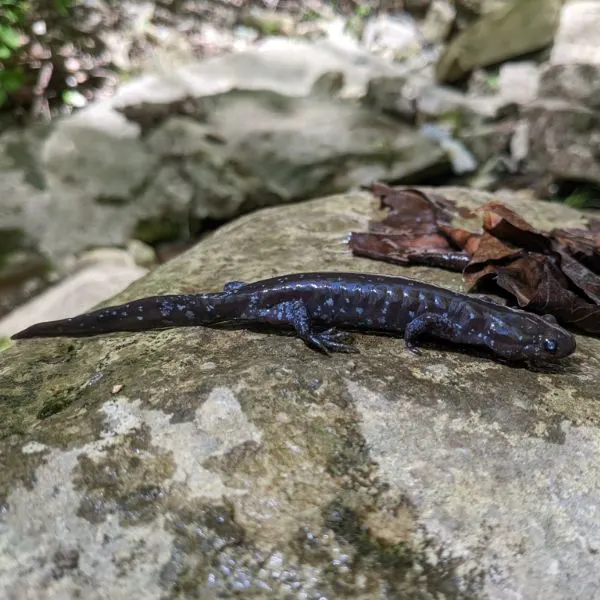
- Experience Level: Intermediate
- Family: Ambystomatidae
- Scientific Name: Ambystoma jeffersonianum
- Other Names: n/a
- Adult Size: 4.3 to 7.1 inches (11 to 18 cm)
- Lifespan: n/a
- Average Price Range: $50
Jefferson’s salamanders are native to the northeastern United States and are also found in Canada. This species is named after Jefferson College in Pennsylvania. This species is found in southeastern Indiana and live in woodlands, grasslands, and upland flatwood habitats. They spend the majority of their life underground or hidden under rocks.
December and January are the earliest this species can breed, but they are usually active in the spring. Vernal pools and shallow woodland ponds are common breeding areas. Eggs are laid in groups of 5 to 30, attached to vegetation. It takes around 2 weeks to a month for eggs to hatch. The larvae stay in the pools they hatch near, and complete metamorphosis in around 2 to 3 months.
This species is usually dark gray, black, or brown, with lighter coloring on its ventral side. Jefferson salamanders may have silver or blue specks on the side of their body. The bodies of this species are slender and moist.
Jefferson’s salamanders are not seen often because of their secretive nature, and nocturnal lifestyle. This salamander feeds on small invertebrates and is carnivorous. They are listed as a species of least concern and are threatened by habitat loss and pollution.
5. Marbled Salamander
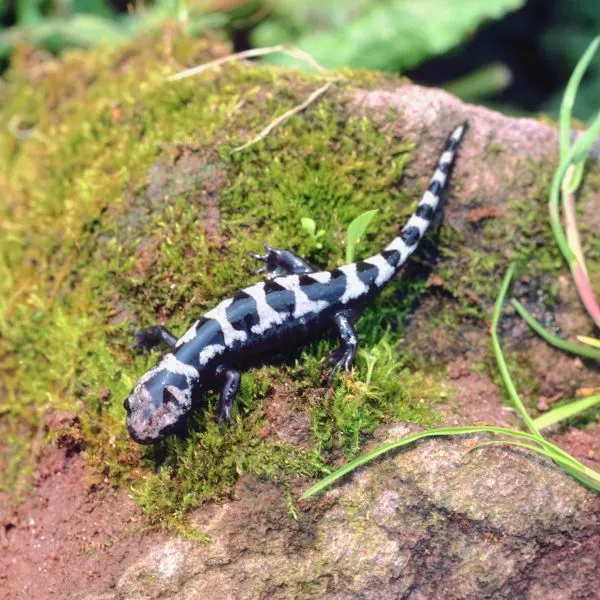
- Experience Level: Intermediate
- Family: Ambystomatidae
- Scientific Name: Ambystoma opacum
- Other Names: n/a
- Adult Size: 3.5 to 4.25 inches (9 to 10 cm)
- Lifespan: 4 years
- Average Price Range: $30
Marbled salamanders are found in the eastern United States, from the New England region to Florida. In Indiana marbled salamanders live in the lowland southwestern portion of the state, and its hills. They also inhabit the upland flatwood region in southeast Indiana.
Marbled salamanders have black or dark brown coloring. White, or silvered colored bands run down their body, and they have a shiny appearance. Younger juveniles do not have crossbands, but a speckled pattern on them. Marbled salamanders that are male have crossbands that appear white, while female crossbands appear grey. The underside of this species is black.
Similar to other salamanders female marbled salamanders are slightly larger than males, which helps with their fertility. September and October are the breeding season for this salamander, and they are often seen during this period migrating to wetlands. Females lay around 30 to 100 eggs, putting them underneath logs, and leaf litter. After hatching it takes around 2 to 9 months for them to metamorphose, and become terrestrial.
The marbled salamander is not a common species, but its conservation status is listed as Least Concern. Worms, slugs, snails, crickets, beetles, and other similar animals are what they eat. If hungry this species is more likely to bite, but overall they are harmless to humans.
6. Mole Salamander
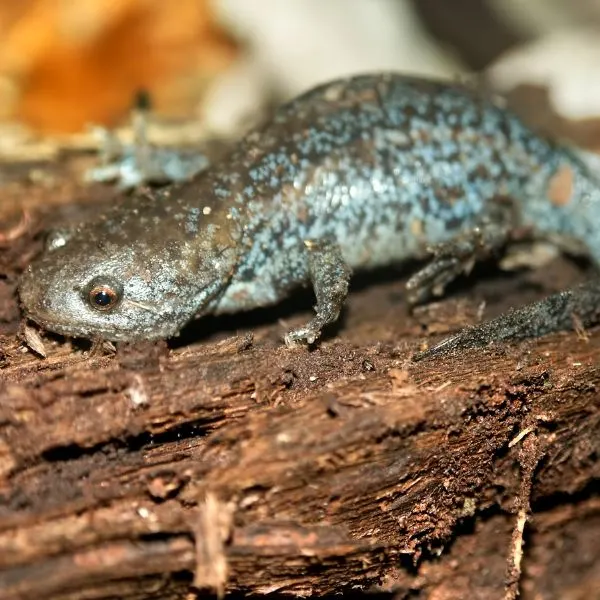
- Experience Level: Intermediate
- Family: Ambystomatidae
- Scientific Name: Ambystoma talpoideum
- Other Names: n/a
- Adult Size: 3 to 4 inches (7.5 to 10 cm)
- Lifespan: 9 years
- Average Price Range: $40
The mole salamander is found in the eastern, and central United States. These species live in lowland, and floodplain habitats. They usually inhabit moist forests near permanent water sources like lakes, streams, or ponds. Mole salamanders in Indiana are listed as an endangered species. Their population loss is primarily due to the destruction of forests, ponds, and swamp habitats they use for breeding.
The spring is when the mole salamander is active the most during the year, spending this season mating. Their eggs are placed near a pond or other similar source of water. As many as 200 to 700 eggs are laid, which take around 20 to 60 days to hatch. It takes around 2 years for juveniles to reach sexual maturity. 45% of adults die before even leaving their pond, due to aquatic predators and droughts.
Mole salamanders have stocky bodies, with short legs, and large heads. They have black, brown, or grey coloring, and a shiny appearance. A silver or bluish-speckled pattern covers them. On their body are 10 to 11 costal grooves, which are furrows that help keep them moist, and are involved in the attachment of muscles to their ribs and vertebrate.
Mole salamanders are active at any time of the day but have higher activities at night. Small insects, worms, and other invertebrates are what this salamander eats. If attacked they lower their heads to expose the parotoid gland, which secretes toxins to protect them.
7. Smallmouth Salamander
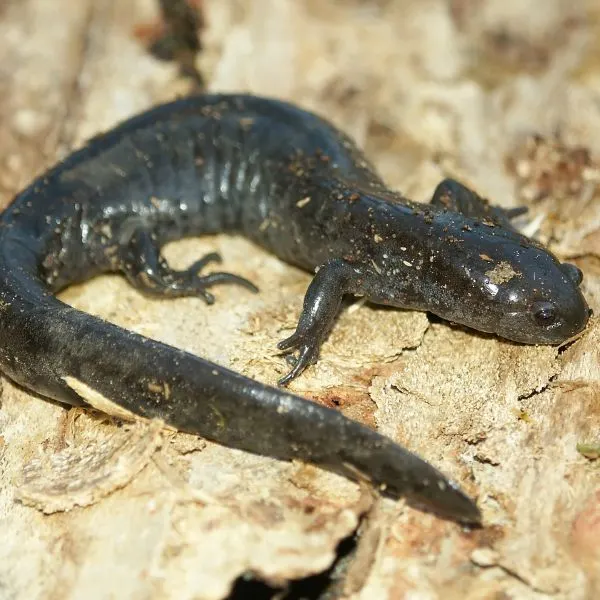
- Experience Level: Intermediate
- Family: Ambystomatidae
- Scientific Name: Ambystoma texanum
- Other Names: Texas salamander
- Adult Size: 4.3 to 7 inches (10.9 to 17.78 cm)
- Lifespan: 15 years
- Average Price Range: $15
The central, and southeastern United States is where smallmouth salamanders generally live. This species is found in Indiana state-wide. They are not seen often and inhabit wetlands, floodplains, marshes, wet fields, and forests with water sources nearby. Smallmouth salamanders inhabit burrows made by crayfish or hide under the cover of natural debris.
Winter and spring are the mating season for the smallmouth salamander, which is when they are spotted the most. In the summer, cold winter, and dry periods of the year they remain inactive, hiding in their burrows. Shallow waters like pools and ditches are used by this species to breed. Females lay up to 700 eggs, and attach them to vegetation underwater in small clumps.
Small-mouth salamanders have dark brown, or grey colors. They are covered in a silver speckling or gray blotch pattern. They have black bellies, covered in small speckles. Their bodies are glossy, with 14 to 15 costal grooves on them. This species is nearly identical to the streamside salamander, with slight differences in their teeth, bone structure, and DNA.
Small insects, earthworms, and even other amphibians are what the small-mouth salamander eats. A very shy species, if disturbed they raise their tail, waving it back and forth.
8. Spotted Salamander

- Experience Level: Beginner
- Family: Ambystonmatidae
- Scientific Name: Ambystoma maculatum
- Other Names: Yellow Spotted Salamander
- Adult Size: 6 to 10 inches (15 to 25 cm)
- Lifespan: 30 years
- Average Price Range: $50
The spotted salamander lives across the eastern United States, and Canada. This salamander is found in many of the forests in Indiana but is absent from the sates sand prairies in the northeast. Spotted salamanders live in woodlands near vernal pools that are used for breeding.
They are fossorial, spending most of their life underground. In the winter they remain active and brumate during the cold season, and in summer they stay underground in dry periods.
The spotted salamander breeds in the months from March to May. They make their way toward breeding ponds when moisture levels are high, and temperatures rise. Females lay around 100 eggs in a clutch, attaching them to underwater vegetation. Eggs hatch in around two months.
When born spotted salamanders are primarily aquatic, and lose their gills in two to four months. Adults of this species are black, sometimes appearing blueish. Spotted salamanders are named after the orangish, or yellow spots that appear on the sides of their body.
Their underside is pink, or gray, with no spots. Female spotted salamanders are slightly larger than males and have brighter spots.
Living in burrows, hiding in leaf litter, and secreting a poisonous toxin from its body is how the spotted salamander protects itself from predators. Skunks, rats, snakes, raccoons, birds, and larger amphibians are what feed on this species. Worms, slugs, spiders, millipedes, crickets, and other invertebrates are what make up the diet of the spotted salamander.
9. Streamside Salamander
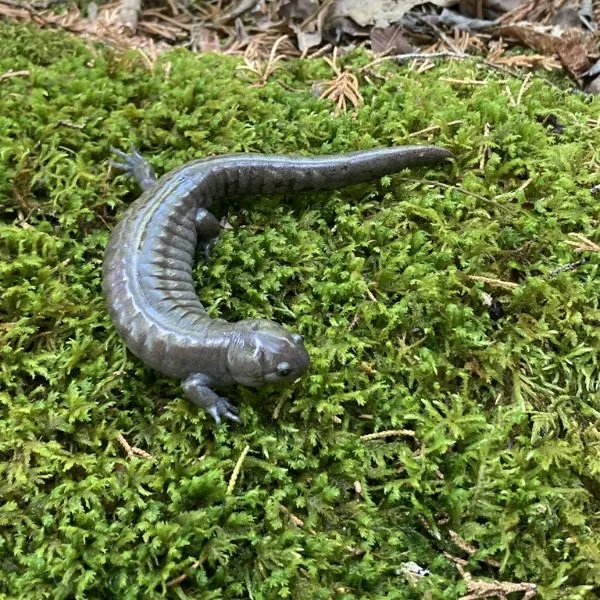
- Experience Level: Intermediate
- Family: Ambystomatidae
- Scientific Name: Ambystoma barbouri
- Other Names: n/a
- Adult Size: 4 to 7 inches (10.16 to 17.78 cm)
- Lifespan: n/a
- Average Price Range: n/a
The streamside salamander is found in North America, mainly in the midwestern United States. In Indiana, this species is mainly found in the central, and southeast regions of the state. Streamside salamanders as their name suggest live near streams in burrows.
Fall is the breeding season for this species, and they continue to do so until the next spring. Rainfall is what causes the streamside salamander to migrate to breeding pools. They spend most of their life underground, coming out in frequent rainfall. Their eggs are laid on the underside of rocks. Clean, and oxygenated water is preferred for this species to breed.
The streamside salamander looks very similar to the appearance of the small-mouth salamander. This species has a gray or tan coloring, with a mottled pattern on them. Their bodies have around 15 costal grooves and have a moist appearance.
The streamside salamanders are listed as near threatened, and they have been affected mostly by habitat destruction. When larvae streamside salamanders are eaten by fish, and as they get older they are preyed on by snakes, birds, and crayfish. Small insects like slugs, snails, and other larvae are what the streamside salamanders eat.
10. Eastern Tiger Salamander
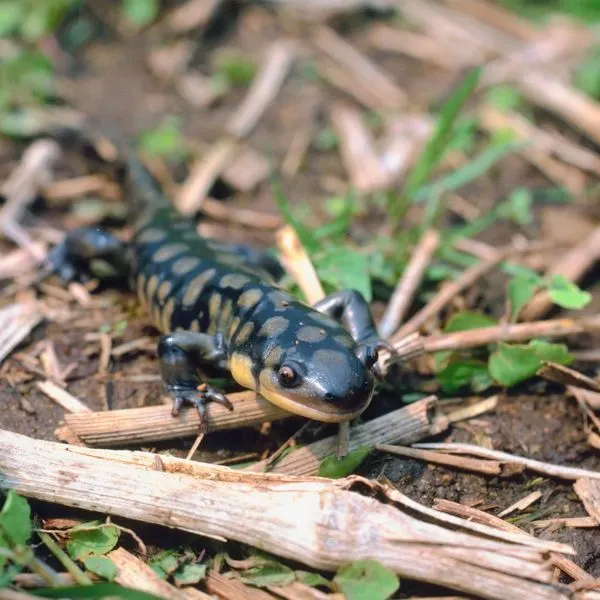
- Experience Level: Intermediate
- Family: Ambystomatidae
- Scientific Name: Ambystoma tigrinum
- Other Names: n/a
- Adult Size: 7 to 13 inches (17.78 to 33 cm)
- Lifespan: 15 years
- Average Price Range: $40
Eastern tiger salamanders are found all across Indiana. The tiger salamander is one of the most widespread salamander species in North America. They live in wetlands habitats or forests near permanent sources of water. Tiger salamanders spend most of their life underground and move to waters to breed. Areas with loose soil are needed for them to live.
Eastern tiger salamanders travel long distances to go back to their birthplace to breed. The winter and early spring is their breeding season. Females lay between 25 to 30 eggs in a mass, leaving them on the bottom of rocks, or attached to vegetation. Eggs take around two weeks to hatch, and 3 months to fully mature and leave the breeding pool.
The eastern tiger salamander has a dark gray, or brown color. They have yellow blotches covering the entirety of their body. Tiger salamanders have robust bodies and large heads. The spots covering their body have no set pattern and vary in size. Their bellies have a yellow, or olive-green color.
Worms, slugs, and other insects are what this salamander eats. Larvae tiger salamanders eat shrimp, small fish, and other larvae. Deforestation and the destruction of their breeding pools are this salamander’s main threat, although they have a conservation status of least concern.
11. Red-spotted Newt
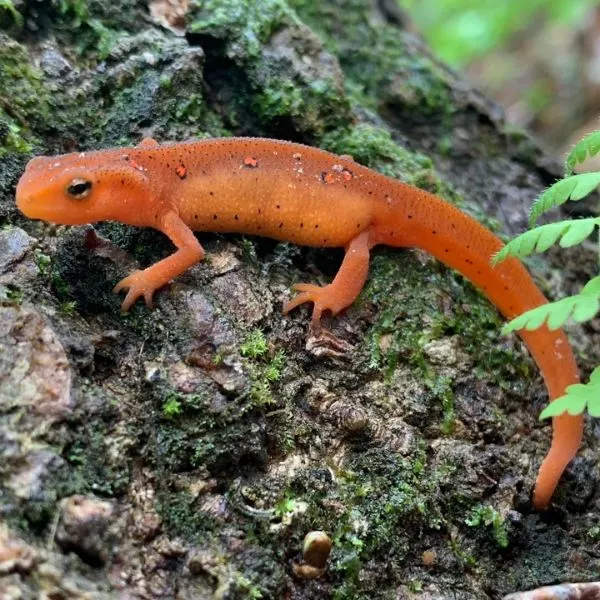
- Experience Level: Beginner
- Family: Salamandridae
- Scientific Name: Notophthalmus viridescens
- Other Names: Eastern Newt
- Adult Size: 3 to 6 inches (7 to 12.4 cm)
- Lifespan: 15 years
- Average Price Range: $20 to $30
Red-spotted newts are native to Indiana, and the eastern United States. The red-spotted newts live near aquatic sources like rivers, wetlands, rivers, and shallow bodies of water. Deciduous forests and woodland habitats are where they are more common. Red-spotted newts are primarily nocturnal and hide under rocks, and leaf litter. They may come out on rainy nights.
The red-spotted newts’ breeding season begins in the winter. They continue to breed until spring, and females choose a mate based on their spots, and tail wiggling motion. Females lay between 200 to 400 eggs, which are submerged underwater in vegetation. It takes around 3 years for this salamander to fully mature, and for adults to return to the water.
The red-spotted newts have olive, yellowish, orange, or bright red coloring. They are covered in orange spots that have a black border. Their skin is scaly and looks slightly drier when compared with other salamanders.
Red-spotted newts feed on small aquatic insects, amphibian eggs, and invertebrates they may find. Red-spotted newts are not seen in the extremely cold, or dry periods of the year. Toxins are secreted from their skin to help predators, and they are even able to regenerate limbs if injured.
12. Northern Dusky Salamander
- Experience Level: Intermediate
- Family: Plethodontidae
- Scientific Name: Desmognathus fuscus
- Other Names: dusky salamander
- Adult Size: 2.52 to 5.59 inches (6.4 to 14.2 cm)
- Lifespan: 10 years
- Average Price Range: $25
The eastern United States is where the north dusky salamander is native. In Indiana, they live in the central, and southern portions of the state. Northern dusky salamanders live in springs, river bottomlands, and the mouths of caves and riparian zones. Northern Dusky salamanders are subterranean, living in burrows near the edges of the water.
Northern dusky salamanders have small and robust bodies. They can have reddish brown, gray, or olive coloring, while their ventral side is pale, and lighter in color. The northern dusky salamander has 14 costal grooves on them. Their bodies are moist, with a black-speckled pattern covering them.
Breeding for the northern dusky salamanders occurs in the spring and fall months. Mating and courting occur on land, and females lay around 10 to 30 eggs under rocks or logs near streams in saturated soil. Females stay with their eggs for up to two months to protect them from predators. Larvae are aquatic and take between 7 to 16 months to metamorphose into adults.
The northern dusky salamander is abundant in their habitat and is listed their conservation status is listed as least concern. This species is still impacted by pollution, and habitat destruction since they’re require areas to breed, and for their young to grow.
13. Four-toed Salamander
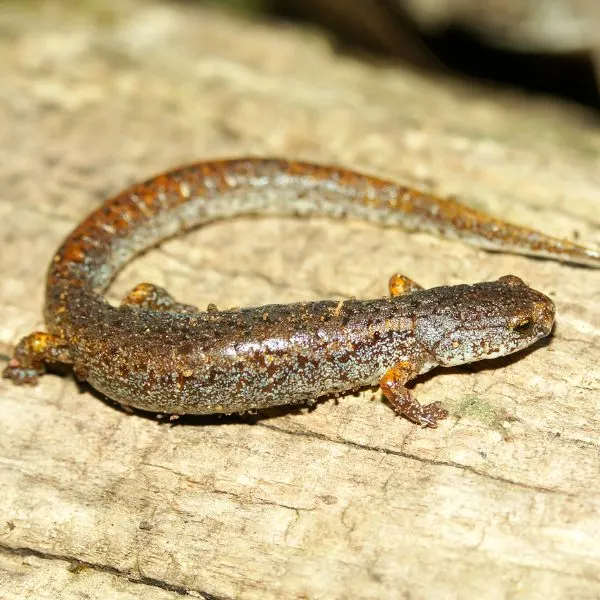
- Experience Level: Intermediate
- Family: Plethodontidae
- Scientific Name: Hemidactylium scutatum
- Other Names: n/a
- Adult Size: 2 to 4 inches (5.1 to 10.2 cm)
- Lifespan: 10 years
- Average Price Range: $40
Four-toed salamanders are mainly found in the eastern United States. This species is in Indiana and is found throughout the state, but is absent from the sand prairies, in the northwest, and Indiana’s bottomland swamps in the southwest. Bogs and forests near water sources are the preferred habitats of the four-toed salamander.
Fall is the mating season for the four-toed salamander, and their activity continues until spring. In the heat of summer, and freezing temperatures of winter they remain inactive. Four-toed salamanders lay their eggs in crevices. They around 4 to 6 weeks to hatch, and they also take the same amount of time to transform out of their aquatic larvae stage.
The four-toed salamander is a very small, and slender species. Their coloring ranges from orange, and brown, to reddish brown. Four-toed salamanders’ most identifying trait is their white bellies, with a black-speckled pattern. The tail is long and has a brighter coloring than the rest of their body. Their back feet only have four toes, which give them their name.
Small invertebrates like spiders, ticks, beetles, and other insects are what the four-toed salamanders eat. Snakes, birds, and mammals like shrews are the main predators this species faces. To defend itself this species can shed its tail, will play dead, or curl up into a ball.
14. Spotted Tail Salamander

- Experience Level: Intermediate
- Family: Plethodontidae
- Scientific Name: Eurycea lucifuga
- Other Names: Cave Salamander
- Adult Size: 4 to 8 inches (10 to 20 cm)
- Lifespan: 10 years
- Average Price Range: $75 to $150
The spotted-tail salamander is found in the southeast, northwestern, and south-central regions of Indiana. The cave salamander is another name for this amphibian since they are found in the mouths, and twilight zones of caves. Forests, swamps, and rock streams are where the spotted tail salamanders live.
Spotted-tail salamander breeding is not well documented, but it is believed they mate in the summer and fall. The later months of fall and early winter are when eggs begin to be deposited, finding places like springs, and the crevices in caves. Females lay between 5 to 120 eggs, which take around 30 days to hatch.
A large species, around 60 to 65% of its body length comes from its tail. They have orange, red, tan, or pale dorsal coloring, with a black-speckled pattern covering them. Spotted tail salamanders have short legs, and on their body are 14 to 15 costal grooves.
Mainly terrestrial, spotted-tail salamanders feed on insects like beetles, slugs, and crickets. They are active at night, seen most on rainy days or nights. This species is harmless, and flee under leaf litter, or in other hidden areas if spotted.
15. Longtail Salamander
- Experience Level: Intermediate
- Family: Plethodontidae
- Scientific Name: Eurycea longicauda
- Other Names: n/a
- Adult Size: 4 to 8 inches (10 to 20 cm)
- Lifespan: 10 years
- Average Price Range: $30
The longtail salamander is native to the Appalachian region in the eastern United States. Found in the twilight zones of caves, this species is also one that some call a cave salamander. Springs and moist forests are also other areas they inhabit. On rainy nights this species may emerge to feed and come out in the early night.
The coloring of the long-tailed salamanders is yellowish, red, brown, or orange. Their bellies are yellow, or gray, sometimes appearing with a speckled pattern. They are covered in a dark speckled pattern, and have small legs with slender bodies. Long-tailed salamander’s tails make up around 65% of their body when fully grown.
Fall until early spring is the breeding season of this salamander. They lay around 60 to 110 eggs, putting them under rocks, and in vegetation. Their eggs are around 3 mm in diameter and incubate for 4 to 12 weeks. The hatchlings are about 10 mm large, and fully-grown longtail salamanders get up to 8 inches.
Small invertebrates like fruit flies, crickets, and worms are what the long-tailed salamanders eat. When hunting at night they may be preyed on by snakes, birds, and small mammals.
16. Southern Two-lined Salamander
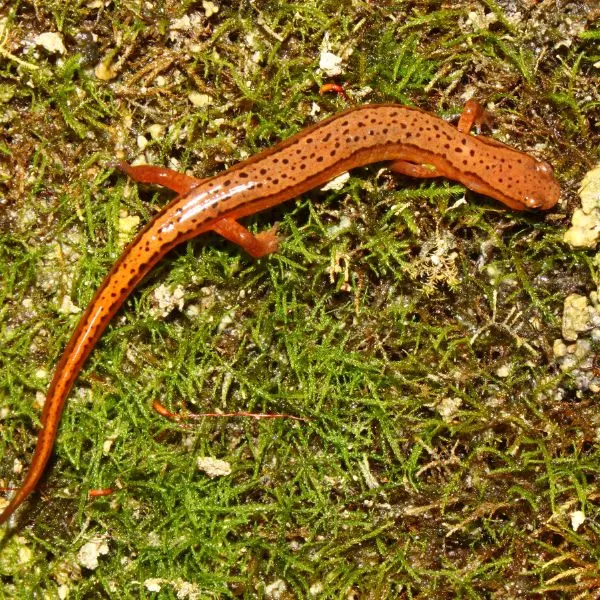
- Experience Level: Intermediate
- Family: Plethodontidae
- Scientific Name: Eurycea cirrigera
- Other Names: n/a
- Adult Size: 2.5 to 4 inches (6.35 to 10.16 cm)
- Lifespan: n/a
- Average Price Range: $15
In the United States, the southern two-lined salamander is found in the southeastern region of the country. Indiana is one of the many states that this spider is found in, and they are only found in the lower southern portion of the state. This species lives in creeks, streams, and other clean flowing water near woodlands.
Southern two-lined salamanders are slender, with small legs. They have a yellowish, or tan coloring, with two black lines running down the sides of their back. Tan or black specks cover them, and they have a moist appearance. Their bellies are yellow. The coloring and markings on their body help them blend into muddy habitats.
In the late winter and early spring months, adults begin to migrate to breeding pools. Females lay between 12 to 110 eggs, placing them under things like rocks, or logs. The southern two-lined salamander eggs begin to hatch in the spring, and they spend their first 1 to 3 years in the water.
Larvae of the southern two-lined salamanders feed on copepods, isopods, and insects they find. Adults may eat invertebrates or small vertebrates. This species is listed as least concern, and is common in its range.
17. Red Salamander

- Experience Level: Intermediate
- Family: Plethodontidae
- Scientific Name: Pseudotriton ruber
- Other Names: Northern Red Salamander
- Adult Size: 20 years
- Lifespan: 6 to 20 years
- Average Price Range: $70 to $100
Red salamanders are found in the southeastern United States, including Indiana. This species is found in springs, creeks, and streams. It is not uncommon for adults to travel inland and go deep into forests.
This species is active at night, and they are often found under rocks, logs, and crevices near streams. In the fall and winter seasons, this salamander spends most of its time in spring, and in the summer and spring months, they are found on land.
Red salamanders can have multiple mates across their lifetime, and breed throughout the year, but not in the cold season. Females lay around 29 to 130 eggs, and are independent after hatching. Eggs take 2 to 3 months to hatch, and their larvae stages last between 18 to 33 months.
The red salamander has bright red or orange coloring. They have scattered spots covering their body, and black markings under their chin and on their mouth. Adult red salamanders may appear brighter and have larger spots.
While their lifespan in the wild is unknown, this species in captivity can live up to 20 years. Red salamanders forage and feed on insects, earthworms, and other invertebrates they find on water and land. To catch prey they can protract their tongue, and use it to catch insects.
18. Ravine Salamander
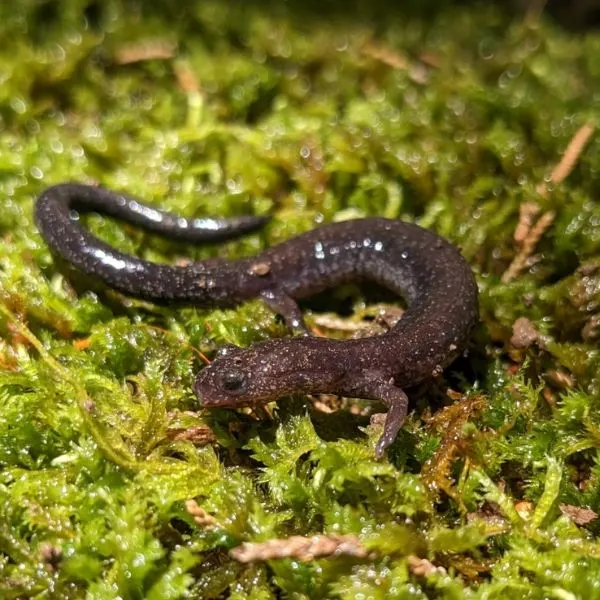
- Experience Level: Intermediate
- Family: Plethodontidae
- Scientific Name: Plethodon electromorphus
- Other Names: n/a
- Adult Size: 2.5 to 5.6 inches (6.35 to 14.22 inches)
- Lifespan: 15 years
- Average Price Range: n/a
As their names suggest, the ravine salamander lives near streams and other fast-moving waters in woodlands. They are not active in the winter, or peak of summer, and aestivate during extreme temperatures. Ravine salamanders are found in the eastern United States, including Indiana. The ravine salamander is terrestrial, and even breeding occurs on land.
The ravine salamander does not have a larvae stage, and its eggs are laid on land, under debris. This species is mainly found in the southeastern region of Indiana. Breedings occur in the winter and early spring, and very little is known about their mating rituals.
The ravine salamander is a small, and slender salamander, with tiny legs. They have dark brown, or black coloring, and are covered in small silver flecks. The ravine salamander on their belly has dark brown or a black shade.
This species is affected by the degradation of their habitats and pollution. They are protected in several areas of their range but are classified as a species that is of the least concern. Ravine salamanders feed on insects like ants, slugs, worms, beetles, and other invertebrates like spiders. Snakes, birds, and carnivorous mammals are some of the animals that feed on ravine salamanders.
19. Redback Salamander
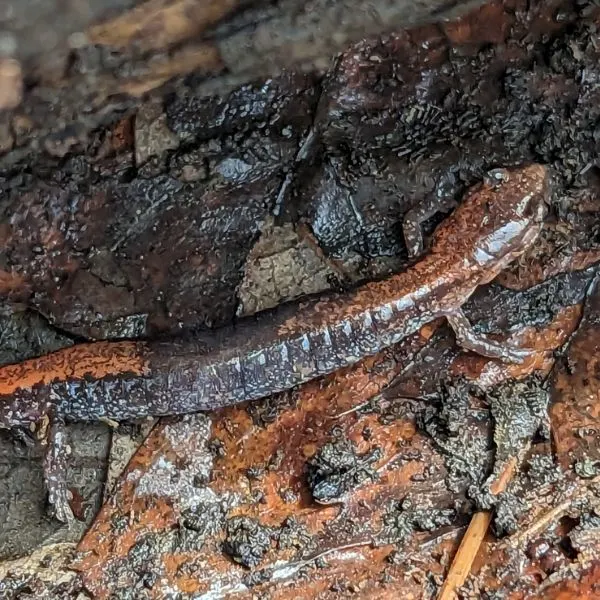
- Experience Level: Beginner
- Family: Plethodontidae
- Scientific Name: Plethodon cinereus
- Other Names: Eastern Red-backed Salamander. Northern Red-backed Salamander
- Adult Size: 2.2 to 3.9 inches (5.7 to 10 cm)
- Lifespan: 20 to 25 years
- Average Price Range: $15 to $30
Redback salamanders are found in the northeastern region of the United States and live all over Indiana. The redback salamander lives in moist, and damp habitats such as woodlands near streams. They are nocturnal and can be found in forests under rocks, logs, and in leaves.
The red-backed salamander can have two color phases. One coloring they appear in is fully gray, or black. They can also have an orange or red stripe that runs down the center of their body. Redback salamanders have a white and black mottled pattern on their underside.
Breeding for this species occurs in the months from October to December. Since it takes so much energy to produce eggs, females breed every other year. 3 to 17 eggs are laid by this species, and they use their mucous to keep eggs moist. It takes around 1 to 2 months for them to hatch, and they reach sexual maturity in two years.
The redback salamander is abundant in its range and has a conservation status of least concern. They feed on animals like millipedes, centipedes, spiders, and other invertebrates. Redback salamanders are able to shed their tail to escape predators, and also rely on the toxic mucous they secrete.
20. Northern Slimy Salamander

- Experience Level: Intermediate
- Family: Plethodontidae
- Scientific Name: Plethodon glutinosus
- Other Names: grey-spotted salamander, slippery salamander
- Adult Size: 4.5 to 8 inches (11.43 to 20.32 inches)
- Lifespan: 20 years
- Average Price Range: $20
Northern slimy salamanders have a wide range in the United States and are found across the regions of southern Indiana. This species is found under rocks, and logs in woodlands, and prefers to live in habitats with clean flowing water. The bottomlands and rocky gorges in Indiana are the habitats they live within the state.
Breeding for the northern slimly salamander takes place in April. This species lays around 6 to 36 eggs, and hatch in around a month. It takes around 5 years for them to reach sexual maturity. This species is affected by habitat loss, but they are abundant in their range.
The northern slimy salamander has black coloring and is covered in white, gold, or red spots. They emit a white sticky secreting to help prevent predators from eating them. They also lash around their tail to scare off predators.
The night is when the species hunts, and they feed on animals like ants, bees, wasps, and beetles. This species is not dangerous to humans, but their toxins can be harmful if you ingest them, or get them into your eyes.
21. Northern Zig-zag Salamander
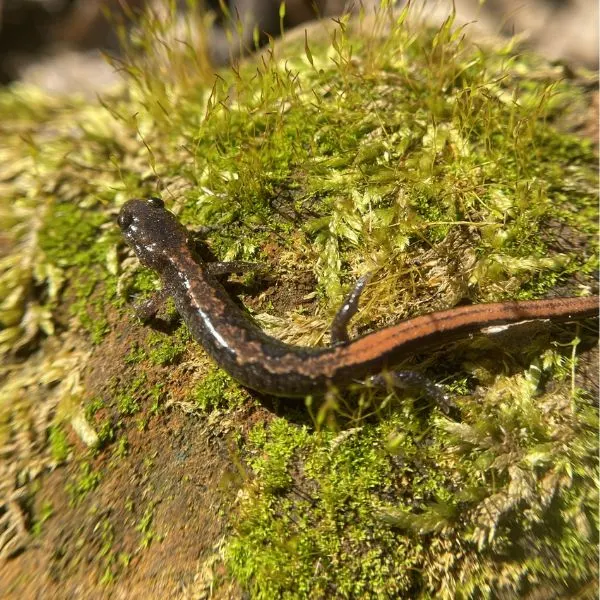
- Experience Level: Intermediate
- Family: Plethodontidae
- Scientific Name: Plethodon d. dorsalis
- Other Names: n/a
- Adult Size: 2.5 to 3.5 inches (6.35 to 8.89 cm)
- Lifespan: 10 years
- Average Price Range: $30
In Indiana, the northern zig-zag salamander lives in the west-central, south-central, and southeast regions of Indiana. This species primarily lives in deciduous forest, and are common in shady ravines or rocky areas. Northern zigzag salamanders are seen most in the spring and fall. They breed during this season and are terrestrial for their entire lives.
Small in size, the northern zig-zag salamander has a slender appearance. They have a dark brown, or gray zig-zag pattern that runs down the center of their back, and have a red, or orangish color. A brownish/gray morph of this salamander exists that lack any squiggly pattern on them.
A secretive species, this salamander is not seen often, as they hide under debris, and in winter they hide in deep burrows. The northern zig-zag salamander feeds on spiders, mites, and other invertebrates at night.
22. Green Salamander

- Experience Level: Intermediate
- Family: Plethodontidae
- Scientific Name: Aneides aeneus
- Other Names: n/a
- Adult Size: 3 to 5 inches (8 to 12 cm)
- Lifespan: 10 years
- Average Price Range: $100
The green salamander is a very rare, and endangered species in Indiana. They have officially only been listed in two counties of the state. Green salamanders live in the Appalachian region of the US. Green salamander’s conservation status is listed as near threatened, and in much of their natural range, they are a rare, and endangered species.
The coloring of this species is green, and they have dark blotches coloring them. This looks similar to moss, or lichen, and allows them to better blend in their environment. Green salamanders are small, and slander, with tiny lungs. They are the only species of salamander in North America that have green coloring.
Habitat destruction is the main reason for his species’ population decline. They live in hardwood forests and are fully terrestrial. In the colder months of the year, they find a deep crevice or hidden area to hibernate. Green salamanders feed on small insects and other invertebrates. Ringneck snakes and other similar snakes are the main predators of this species.
23. Lesser Siren
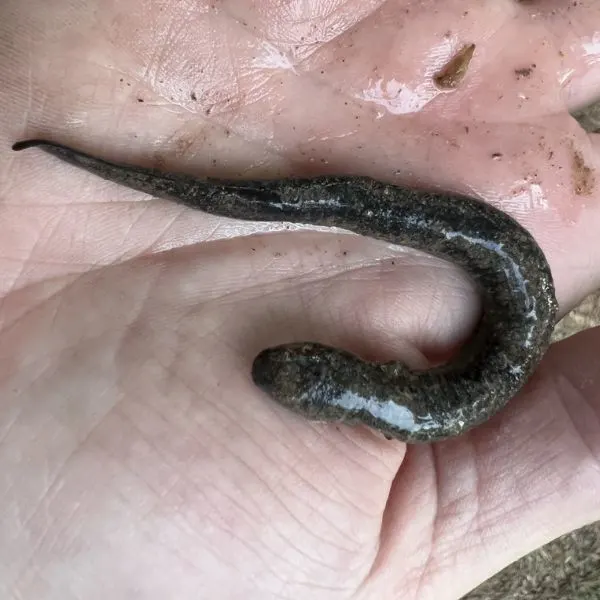
- Experience Level: Intermediate
- Family: Sirenidae
- Scientific Name: Siren intermedia nettingi
- Other Names: n/a
- Adult Size: 7 to 27 inches (17 to 69 cm
- Lifespan: Siren intermedia nettingi
- Average Price Range: $30 to $80
The United States and Mexico are where the lesser siren is found. Also seen in Indiana, this species is found across the state, but is not commonly come across. The lesser siren is permanently aquatic, living in ponds, bottomlands, and floodplains with lots of aquatic vegetation.
This species has an elongated body, and only has a pair of two front legs with four toes. They have an olive green, gray, or back coloring, with a speckled pattern on them. External gills are located on the sides of their head, and their bellies are gray.
The lesser siren is a nocturnal species and is not seen often since it hides under rocks and other underwater debris. Aquatic invertebrates like worms, snails, and crustaceans are what this species eats. Wading birds, water snakes, alligators, and large fish are the predators these aquatic salamanders make.
FAQ
Where do salamanders live in Indiana?
Salamanders live all over Indiana and are most commonly seen in lakes, ponds, streams, and other small sources of water near woodlands.
Some species like the hellbender only live in the water, while others are terrestrial, or semi-aquatic. Learning about the different salamanders in Indiana lets you know where to look for them. Under rocks, logs, and leaf litter are common areas salamanders hide.
Are salamanders in Indiana poisonous?
Salamanders secrete a toxin from their body, which can irritate eyes, and skin, or make you sick if ingested. While not deadly to humans, you should always wash your hands after touching one.
Some salamanders are more toxic than others, varying based on the species. In general, salamanders should not be handled since touching them can also transfer harmful toxins to them, since they absorb things through their skin like other amphibians.
In Indiana when are salamanders active?
The rainy months of spring are when salamanders are active most. Due to their secretive nature salamanders are not seen often, as they hide under debris, and are only active at night.
Rainy nights during their breeding season are the best time to spot a salamander, and it may vary depending on the species. Each species may have its own preference for activity.
Wrapping up
In the world, there are over 600 species of salamanders. The eastern region of the United States has the most salamander species than anywhere else in the world. Indiana has 23 salamanders to look out for, which make up just a few of the 300 amphibian species that inhabit the United States.
Salamanders are not dangerous to humans, and we are more harmful to them. Amphibians including most salamander species are at threat of losing large portions of their population due to the destruction of their habitat, pollution, and diseases. Protecting the diverse habitats of Indiana allows us to appreciate its beauty, and protect the animals like salamanders that live within them.
Other nearby states
